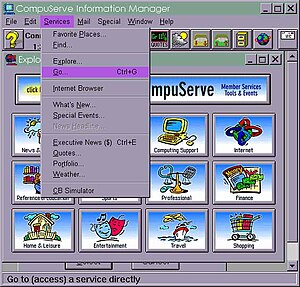CompuServe Information Manager
 From Wikipedia - Reading time: 3 min
From Wikipedia - Reading time: 3 min
This article needs additional citations for verification. (March 2010) |

CompuServe Information Manager (CIM) was CompuServe Information Service's client software, used with the company's Host Micro Interface (HMI). The program provided a GUI front end to the text-based CompuServe service that was at the time accessed using a standard terminal program with alphanumerical shortcuts.
History
[edit]Issued at the same time as the GUI-only America Online began to grow in popularity, CIM was available for MS-DOS ("DOSCIM"), Microsoft Windows ("WinCIM"), Macintosh ("MacCIM"), and OS/2 ("CIM for OS/2") and allowed access to CompuServe's features, such as its forums, chat, e-mail, and messaging facilities; these continued to be accessible via standard communications software using alphanumeric shortcuts. The first versions were released in around 1990. Version 2.0.1, released in 1994, included a version of the Mosaic web browser.[1]
Later, CompuServe switched parts of its service over to its new binary protocol, Host Micro Interface. Unlike its predecessor, this new protocol was not usable directly via a telnet client thus requiring the use of specialised client software like CIM. Version 3.0 (CompuServe for Windows 3.0), in 1997, was intended to compete head-on with AOL, and was released amid an advertising campaign in which CompuServe was briefly re-branded as "CSi".
After CompuServe was purchased by AOL in 1998, CompuServe began providing CompuServe branded versions of the AOL client software known as CompuServe 2000 and CompuServe 7 and its protocols as a way to access the service. However, it remained possible to connect to WinCIM via HMI, which became known as the "CompuServe Classic" service.
Other CompuServe client programs
[edit]References
[edit]- ^ "Which Way To The Internet, Please?". Smart Computing. Vol. 5, no. 6. June 1997. Archived from the original on 2012-02-05.
 KSF
KSF